A New Theory on *T*C* Sud Coinage: Tlalchapa, 1813
by Max A. Keech
Copper SUDs were first struck by Jose Morelos in 1811. In 1813, *T*C* SUDs of a more refined style and better production quality were issued. These *T*C* style SUDs have long been described as Tehuacan issues in which *T*C* abbreviates the “Tierra Caliente” region where they were supposedly struck. Based on new research which is detailed below, I believe the *T*C* style SUDs were issued much further west in Tlalchapa, by Supreme Junta forces under the command of Junta member Father Sixto Berdusco (Verduzco)Berdusco is most often spelled Verduzco in both English and Spanish sources including Bancroft. We have chosen to utilize the paternal spelling preferred by Spanish historians of the War for Independence. This spelling is also consistent with the Berdusco’ signature.. In the pages that follow you will see a September 1813 Morelos decree on which this determination rests. Before detailing this Tlalchapa assignment, we first begin with a quick historical overview followed by past *T*C* SUD attributions. Then we review the Tlalchapa origin theory and conclude with a detailed look at individual *T*C* SUD issues.
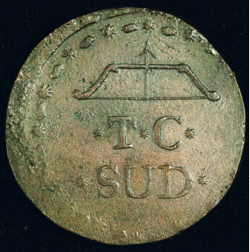
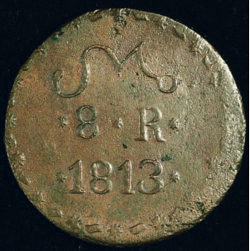
1813 *T*C* SUD 8R
Campaigns of Morelos
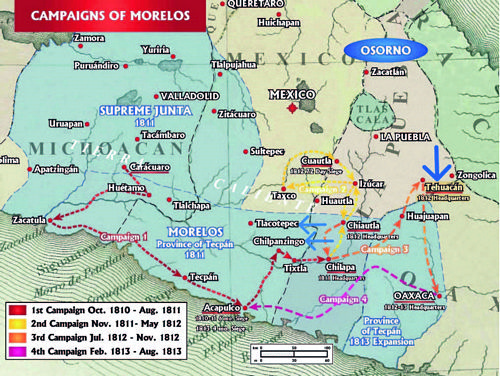
In 1811, during his first military campaign, Jose Morelos found himself in desperate need of funds and issued a proclamation authorizing the coinage of copper SUDs redeemable in gold or silver at a later date. Copper SUDs of a complex floral design, which are commonly designated “ornate”, were initially struck in Tecpan and then sometime later in Chilpancingo. During Morelos’ 1812-13 military campaigns the production of copper SUDs was expanded to include simpler, non-ornate styles in locations other than Tecpan and Chilpancingo. Sometime in 1813, a new style of SUD was created with the abbreviation *T*C* prominently displayed on the reverse. These *T*C* style SUDs show finer die work and better production quality than the ornate and non-ornate style SUDs that preceded them.
Past *T*C* Attributions
For many decades, *T*C* was thought to be an acronym for Tierra Caliente or “Hot Land”, designating the near costal, southern region where the *T*C* SUDs were presumed to have been made. This theory originated with Layman Low’s 1886 publication “A Sketch of the Coinage of the Mexican Revolutionary General Morelos”. In 1938 Dr. Alberto Pradeau expanded on Low’s theory with the hypothesis that *T*C* SUDs were struck in Tehuacan as a way to differentiate the Tehuacan SUDs from others produced by Morelos. Pradeau’s theory, detailed in his “Numismatic History of Mexico”, has served as the primary reference on the coinage of the War for Independence since its publication in 1938 and hence Tierra Caliente and Tehuacan have become synonymous with *T*C* SUDs.
There are problems however with Pradeau’s theory.
- This theory lacks any type of documentary support.
- Since the legend “SUD” already describes the area of issuance the interpretation of TC as Tierra Caliente seems unlikely.
- An issue of Tehuacan also appears unlikely. Insurgent forces took Tehuacan in May 1812. Morelos then made it his headquarters in August before departing for Oaxaca in October 1812. Given the size and importance of Tehuacan, it is likely that Insurgents struck SUDs in Tehuacan in 1812. These SUDs would have been of a non-ornate style. We know this based on a Morelos decree of September 1813 which is presented shortly. Five different types of non-ornate SUDs were made during Morelos’ various campaigns and whatever non-ornate SUD style was struck at Tehuacan would have identified it as a Tehuacan issue and, hence, there was no need to change the design to differentiate it.
- *T*C* SUDs are of a more refined style and better manufacturing quality than other SUDs produced in 1811-13. This would seem to indicate a new minting location with better equipment rather than an issue of Tehuacan.
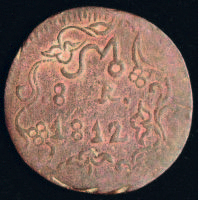
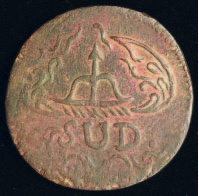
1812 Ornate SUD 8R
<
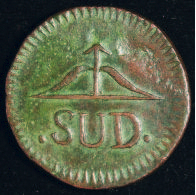
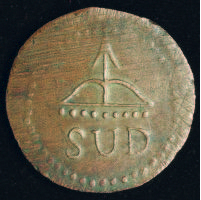
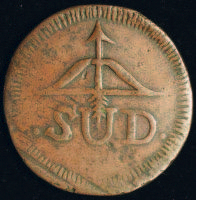
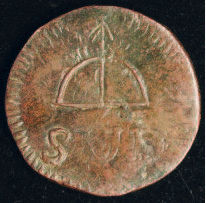
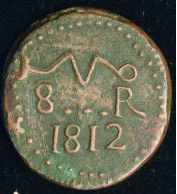
Five Major Types of Non-Ornate SUDs: Plain, Dotted, Feathered Arrow, Circular & 8…R
Other Theories
Numismatists have recognized the problems associated with the Tierra Caliente and Tehuacan assignments and have proposed other theories for *T*C* coinage. In 2015, Garcia Castro suggested “Treasure of the Capital” or “Treasury of Chilpancingo” as possible *T*C* associations. This theory is based on Morelos’ 13 July 1811 proclamation which authorized SUD coinage. This proclamation states that SUDs will be struck at the Treasury of said Capital (“tesoreria de la expresada capital”), referring to the capital of the Province of TecpanOlvera Garcia, Jorge; Garcia Castro, Rene; Garcia Pena, Analida. El Caudillo del SUR: forjador de la Nación Mexicana (Toluca: 2015), page 127. Perhaps, according to this theory, *T*C* SUDs were struck in Chilpancingo following Morelos’ September 1813 recall of SUDs for counterstamping. Like Tierra Caliente, this theory has challenges. Ornate style SUDs were first struck in Chilpancingo and Tecpan in 1811 during Morelos’ first campaign. We can be certain of this because ornate SUDs were the only SUD style struck in 1811.
Given the importance of Chilpancingo, it is likely that ornate style SUDs continued to be struck in 1812-14. In fact, ornate SUDs dated 1813-14 are the most plentiful of all copper SUDs. Why would Chilpancingo switch from ornate to *T*C* SUDs in late 1813 and then revert back to ornate SUDs in 1814? Critically, the die work and production quality of *T*C* SUDs is superior to either the 1813 or 1814 ornate SUDs which would have been made in Chilpancingo. If *T*C* style SUDs were struck in Chilpancingo they would be physically similar to the ornate SUDs struck in Chilpancingo in 1813 and 1814. Because of these physical differences, I believe Chilpancingo, like Tehuacan, can be eliminated as the source of *T*C* SUDs.
Gomez Wulschner and several other specialists have proposed Tlacotepec as the origin of *T*C* SUDsOlvera Garcia, et al, page 90. . Tlacotepec is a small town separated from Chilpancingo by 120 km of rugged terrainOn 24 January 1814 the Royalist Lt.-Col. Armijo surprised the Insurgent Congress near Chilpancingo, capturing 10,000 pesos in copper along with their archives and baggage. Following this, the Rebel Congress relocated to Tlacotepec, arriving before the end of January 1814. They were there for the month of February 1814 before fleeing northwest to Michoacan province, arriving in Tlalchapa by the first week of March 1814. . While a *T*C* abbreviation of Tlacotepec is theoretically possible, to my knowledge there is no documentation indicating coinage was struck in Tlacotepec in 1813 prior to the Insurgent Congress’ arrival in 1814. And if Tlacotepec did produce SUDs in 1813, we would expect die work and production quality similar to Chilpancingo rather than the finer quality of the *T*C* SUDs. We would also expect SUD production to continue in Tlalcotepec in 1814 during its occupation by the Insurgent Congress. If so, SUD production in Tlalcotepec during 1814 would have to be of the inferior ornate style, the only style SUD struck in 1814. Based on die work and production quality, I believe that Tlacotepec, like Tehuacan and Chilpancingo, can be excluded from consideration as the location of *T*C* SUD manufacture.
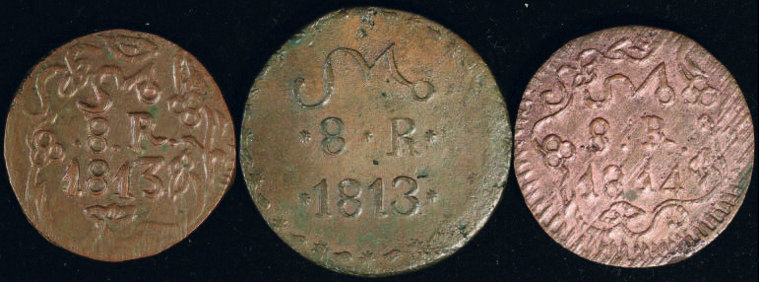
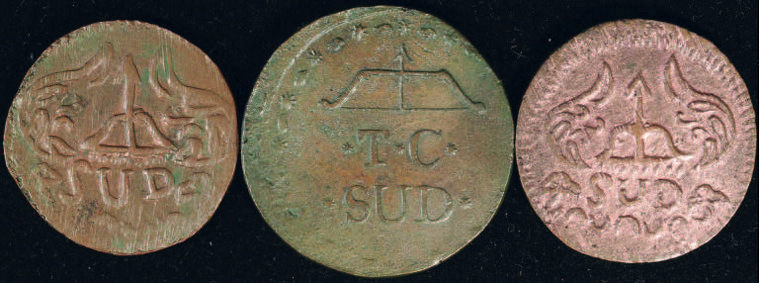 Comparison of 1813 ornate, 1813 *T*C* and 1814 ornate copper SUDs
Comparison of 1813 ornate, 1813 *T*C* and 1814 ornate copper SUDs
Tlalchapa. A New Theory on *T*C* SUD Coinage
Based on the research and analysis outlined below, I believe *T*C* SUDs were produced in Tlalchapa by forces under the command of Supreme Junta Member Sixto Berdusco. Tlalchapa has documentary support, had reason to differentiate their SUDs from those produced by Morelos’ forces and explains the physical differences between *T*C* SUDs and the standard SUDs produced in the south. Tlalchapa, to my knowledge, has never been considered as the source of *T*C* SUDs even though it is specifically mentioned in the Morelos’ decree which follows.
As previously mentioned, copper SUDs were initially produced in a complex style which is commonly designated as ornate. In 1812-13, as the campaigns of Morelos brought more cities under his control, SUD production was expanded by producing simplified, non-ornate styles in these new locations. Counterfeiting of these non-ornate copper SUDs began almost immediately. As evidence, numerous Morelos letters of this period complain about the incessant problems of counterfeiting. On 30 September 1813, Morelos issued a proclamation in Chilpancingo which recalled copper SUDs for a three-month period of inspection and counterstamping:
Jose Maria Morelos; Chilpancingo, 30 September 1813
Don José María Morelos, Servant of the Nation, and Generalissimo of the Armies of this North America, by universal vote of the people, etc.
Having received representatives from various towns, about the harm caused to many unfortunate individuals who are suffering with their families by accepting the counterfeit copper coins manufactured by the wicked, and the coins minted in different territories without the corresponding license of this authority, which the people received with sincerity and in good faith, in return for their personal work including all aspects of their industry and services, to provide for the support and subsistence of their women and children.
Desiring to provide all possible means to avoid these evils or at least to diminish them, so that they do not become so detrimental to the poor, I have decided to grant, for a specific term of three months, that anyone who has this type of currency, which is not from the mints of Tlalchapa, Chilpancingo and Oaxaca, which are authorized according to the respective decree, shall send them to the treasury of this new city, where it shall be revalidated with the stamp of my letters and two little stars. Under these circumstances it shall be received everywhere, with the understanding that after said term, whoever possess the aforementioned currency will lose it and the penalties for counterfeiting will be enforced.
And so that this provision has punctual and due compliance, and no one alleges ignorance, I command this decree be published in the capitals of the conquered provinces, where the necessary copies will be sent to their respective jurisdictions, the term running from the day in which each one is published.
Given at Chilpancingo Headquarters on the 30th day of September of 1813.
Jose Maria Morelos. By orders to S.A Juan Nepomuceno Rosáinz. Archivo General de la Nacion abbreviated AGN; infidencias, t. 144, f. 6; Lemoine, Morelos, 1965, doc. 118, pp. 382-383. My appreciation to Ramiro Cerecer for his translation of this important document.
This important Morelos decree, when coupled with the copper SUDs themselves, serves as a Rosetta Stone to unlock some of the mysteries surrounding these SUD issues. The decree informs us that:
- SUDs from Tlalchapa, Chilpancingo and Oaxaca were not counterstamped as part of the recall effort.
- SUDs issued at locations other than Tlalchapa, Chilpancingo and Oaxaca were recalled and counterstamped.

Non-ornate SUDs (bottom & right) are often counterstamped while *T*C* and ornate style SUDs (left & top) are not often counterstamped..
Based on an examination of 830 copper SUD eight reales we can integrate the following facts with Morelos’ decree:Copper eight reales are used for this analysis because copper eight reales are primarily what were counterstamped. Very few copper minors with Morelos’ counterstamps are known. The 830 examples come from a number of large collections and are thought to be representative of the overall SUD population.
- Non-ornate style SUDs were the coins recalled and counterstamped. More than 50% of all non-ornate style SUDs display Morelos counterstamps. Based on this observation, we can assign the five non-ornate SUDs styles to cities other than Tlalchapa, Chilpancingo and Oaxaca (although not specific non-ornate styles to specific cities).Interestingly, Morelos’ decree appears to approve the counterfeit SUDs already in circulation for counterstamping, thereby accepting responsibility for future repayment in silver, to avoid injury to his unsuspecting subjects! This interpretation would explain the large number of contemporary counterfeits encountered today with Morelos’ counterstamp.
- Ornate and *T*C* style SUDs were not recalled for counterstamping by Morelos’ decree. Less than 5% of *T*C* and ornate style SUDs display Morelos’ counterstamps. This is in sharp contrast to the non-ornate style SUDs! Based on this observation, we can assign the *T*C* and ornate style SUDs to Tlalchapa, Chilpancingo and OaxacaOaxaca SUD are also generally not counterstamped which should be expected for this 1814 issue produced after the late 1813 counterstamping effort.. But which style SUD to which city?
- *T*C* SUDs are of a different manufacture than ornate (and non-ornate) style SUDs. In addition to their finer die work, *T*C* SUDs have a better production quality. They are on larger planchets (averaging 39mm vs. 35-36mm) and of a more uniform thickness. *T*C* SUDs are stable when stacked while ornate SUDs are unstable due to their uneven thicknesses. These die work and production differences indicate a different minting location with different equipment and craftsmen. These important physical characteristics have often not been considered in attempts to identify the source of *T*C* SUD production.
Morelos’ proclamation makes it clear that SUDs were minted in Tlalchapa and that these SUDs were not recalled for counterstamping. This reference to Tlalchapa SUDs appears to have escaped past examination, perhaps because of its distance from Morelos’ operations. The Tlalchapa SUDs were either of a *T*C* or ornate style as those were the SUDs not generally counterstamped. I believe *T*C* style SUDs are the logical choice for Tlalchapa.
Tlalchapa
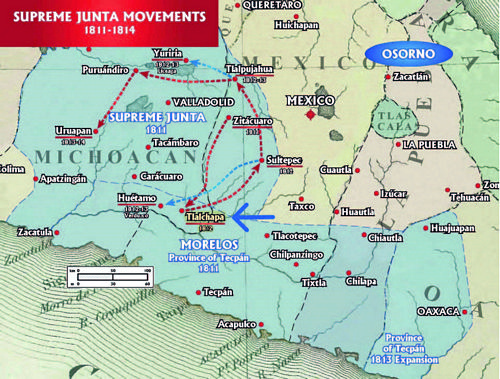
Tlalchapa is a small city in the current state of Guerrero on the eastern edge of the Province of Michoacan. During the War for Independence, Tlalchapa was a stronghold of the Supreme Junta. When the Supreme Junta was forced out of Zitacuaro in January 1811, they first fled to Tlalchapa before relocating the Insurgent government to Sultepec. In June 1812, when the three members of the Supreme Junta decided to separate to avoid providing the Royalists with a concentrated target, Junta member Farther Sixto Berdusco headquartered in Huetamo, 70 km west of Tlalchapa. Berdusco was given command of western Michoacan Province including nearby Tlalchapa. Simultaneously, Morelos was admitted as the fourth member of the Supreme Junta with command of the south.
Father Sixto Berdusco (Verduzco)
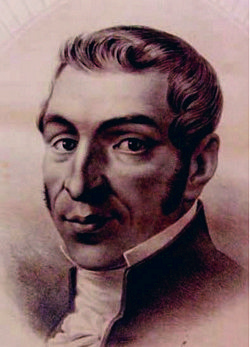 Before the revolution Berdusco served as the priest of Tuzantla, a parish near Caracuaro, making him intimately familiar with western Michoacan. Berdusco was a Morelos loyalist and his representative on the Supreme Junta. In March 1813, escalating conflict among the three of the four Supreme Junta members resulted in Berdusco and Liceaga breaking with López Rayón, each declaring the other unfit. Berdusco actively undermined López Rayón in his communications with Morelos. Morelos, who remained neutral, accurately saw this dispute as detrimental to the Insurgent cause and began considering leadership changes which would culminate in the Congress of Chilpancingo. It is probably around this time in 1813 that Tlalchapa, under Berdusco’s command, produced their *T*C* SUD coinage. The *T*C* designation would have served to identify the Tlalchapa location of production as well as differentiate this coinage from Morelos’ SUDs. The Supreme Junta had skilled die engravers and superior minting technology as evidenced by the Supreme Junta’ 1812-13 continuous legend style coinage. This would explain the superior die work and production quality of the Tlalchapa *T*C* SUDs when compared to Morelos’ SUDs manufactured in the south.
Before the revolution Berdusco served as the priest of Tuzantla, a parish near Caracuaro, making him intimately familiar with western Michoacan. Berdusco was a Morelos loyalist and his representative on the Supreme Junta. In March 1813, escalating conflict among the three of the four Supreme Junta members resulted in Berdusco and Liceaga breaking with López Rayón, each declaring the other unfit. Berdusco actively undermined López Rayón in his communications with Morelos. Morelos, who remained neutral, accurately saw this dispute as detrimental to the Insurgent cause and began considering leadership changes which would culminate in the Congress of Chilpancingo. It is probably around this time in 1813 that Tlalchapa, under Berdusco’s command, produced their *T*C* SUD coinage. The *T*C* designation would have served to identify the Tlalchapa location of production as well as differentiate this coinage from Morelos’ SUDs. The Supreme Junta had skilled die engravers and superior minting technology as evidenced by the Supreme Junta’ 1812-13 continuous legend style coinage. This would explain the superior die work and production quality of the Tlalchapa *T*C* SUDs when compared to Morelos’ SUDs manufactured in the south.
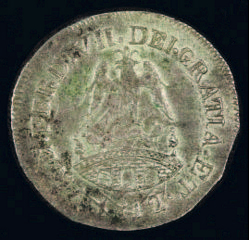
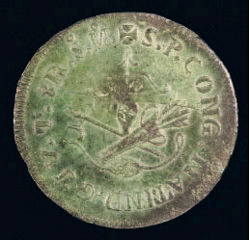
1812 Supreme Junta Continuous Legend 8 Reales
It should again be emphasized that, based on Morelos’ September 1813 decree, either *T*C* or ornate style SUDs were struck in Tlalchapa since these are the SUDs that were not recalled and counterstamped. The physical evidence supports *T*C* style SUDs and this theory has the documentary support that is lacking for Tehuacan, Chilpancingo and Tlalcotepec.
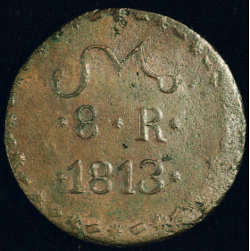

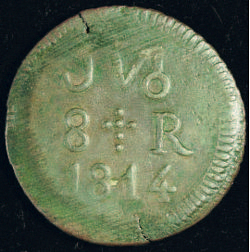
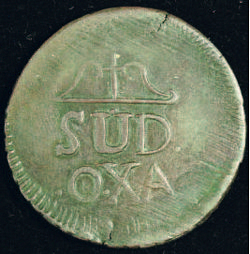
813 *T*C* & 1814 Oaxaca SUD 8 Reales
Is *T*C* a reasonable abbreviation or mintmark for Tlalchapa?
Consider the example of Oaxaca where another member of the Supreme Junta, Ignacio López Rayón, used the mintmark O.X.A. for Oaxaca. In early 1814 Oaxaca struck SUDs with OAXACA and O.X.A. legends to identify their origin. This occurred after Morelos’ crushing defeat on 5 January 1814, at Valladolid when former Supreme Junta members Liceaga, López Rayón and Berdusco, acting with other Congress members, assumed executive power. López Rayón was appointed Commandant General and given command of Oaxaca and Tecpan. Shortly thereafter, 1814 Oaxaca SUDs were struck in a style somewhat similar to the *T*C* style SUDs. The Oaxaca die work and production quality is similar to the *T*C* SUDs. While similarities exist, the lettering and bow & arrow styles are different on the *T*C* and Oaxaca style SUDs indicative of different die engravers.
The mission of General López Rayón in Oaxaca was to correct numerous problems that had developed after Morelos’ departure in February 1813. These problems included inept administration and the ills of copper money. Without silver to properly remedy the latter situation, a better executed copper issue probably had to suffice. It appears López Rayón or his lieutenant, General San Martin, sought to differentiate the Oaxaca SUDs in the same manner theorized for Tlalchapa. Numismatic writers have previously commented on the similarities between the *T*C* and Oaxaca SUDS. The possible involvement of Supreme Junta members, administrators or craftsmen in both issues offers a reasonable explanation for these similaritiesI have also considered whether *T*C* SUDS could have been struck in Oaxaca in 1813 before López Rayón’s arrival with *T*C* representing Treasury of the Capital. This alternative theory could explain the similar die work and production quality of the *T*C* and Oaxaca SUDs. Problematically, this theory relies on Morelos’ July 1811 Tixtla decree previously mentioned. Unexplained is why two years elapsed before the adoption of a “Treasury of the Capital” legend in Oaxaca in 1813. Improbably, this scenario also requires that López Rayón changes the design from *T*C* to Oaxaca style SUDs in January 1814. A change that seems unnecessary given the high production standards of *T*C* style SUDs. The lettering and bow & arrow style changes are also unexplained if both issues were produced in Oaxaca. While considered, this alternative is unlikely..
Epilogue
The Royalist army, commanded by Colonel Melchor Alvarez, retook Oaxaca on 29 March 1814, so we can pinpoint the Oaxaca SUD coinage to the first three months of 1814. Tlalchapa and Huetamo would continue to be Insurgent strongholds. The Congress, with Liceaga as President and Berdusco as a Vice President, occupied Tlalchapa and Huetamo from March to June 1814, a chronology evidenced by numerous decrees issued during this period. Father Berdusco was captured in 1817 and imprisoned for 32 months. He was released upon Iturbide’ accension and would go on the serve two terms as a senator for the State of San Luis Potosi. Sixto Berdusco died in Mexico City in 1832 at age 59.
